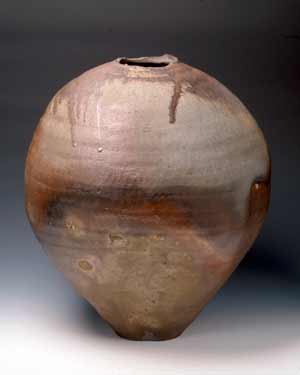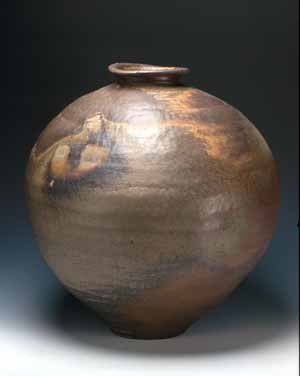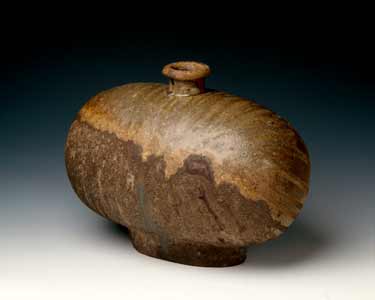The Poetics of Primitive Pottery
Published in Ceramics: Art and Perception, No. 20, 1995, 43-45.
Primitive pottery is simultaneously ancient and fresh. It evinces the presence, if not the passage of eons, while exhibiting traces of the maker's hands and the user's touch. A primitive spirit permits a special poetic melding of the past with the future. Pottery's unique language is ideally suited to such a juxtaposition. It is, however, an easily garbled tongue. Although I don't always agree with Bernard Leach's writings, his 1928 observation is still apropos: "The potter, in his concepts, must possess such a sheer love of truth as will carry him past the dangers of revivalism on the one hand and of futurism on the others." 1 How the co-mingling of past, present and future is achieved is perhaps the most critical and a perennial issue in the making and assessing of pottery.

All photos by Hubert Gentry
I use the word 'primitive' to isolate the practical nuances of earthiness--qualities such as rough, unrefined, vigorous and unpretentious--as well as the spiritual strength of such art. Korean Silla pedestal bowls, Japanese medieval storage jars, North American Mimbres painted bowls and English earthenware pitchers of the Middle Ages are all technologically primitive in character, carless in craftsmanship and full of vitality. Not all historic primitive art is equally stimulating. Not all objects energize an artist's expressive struggle. This essay isn't concerned with the value of all primitive art but simply builds upon the observation that primitive qualities--in old and new art--potently speak to each of us.
Contemporary critics of Cezanne found his painting to be primitive. George Heard Hamilton describes their assessment as follows: "Instinctive, ingenuous, naive, sincere and child-like taken together are words which characterize the primitive artist, and in such terms Cezanne was interpreted by those who were favourably disposed to his art. But primitivism has negative implications. It could also mean incomplete, unfinished, awkward or even impotent in the sense of being artistically incapable of realising...one's artistic intentions." 2
This is an equally apt summation of critical reaction to primitiveness in contemporary pottery. Primitive qualities are expressive of natural weatheredness and creative directness. A primitive process entails and conveys an unfettered approach to technique, thus appearing to some as a lack of technique. Earthiness can remove the layers of technical sophistication that often afflict pottery. Whether by modern intention and/or historical circumstance, a casual attitude towards the purity of materials turns refinement into a complex expressive ingredient. The impure character of material and process plays against a purified sense of form. Austerity meets abandon.
I associate Hamada with a quote that may be apocryphal, but which rings true: the best pottery comes after 20 years of learning followed by 20 years of unlearning. Hamada describes it as the flowering of a second childhood in terms of the four seasons: "The best bowls are made by children who are unselfconscious. But just as you are reaching the peak of skill--summer--this is when the danger sets in. You become aware of your skill, and then you must get beyond that awareness before you can reach autumn and then winter. Then you must...arise with the next spring when the new buds form--the second spring. This is the period Japanese handcraftsmen know to be the time to develop their true craft.... [It is] a second childhood." 3 The paradoxical goal is to combine child-like spontaneity with mature skill and vision. I would suggest that a primitive aesthetic similarly entails complex tensions between precision and disregard, skill and happenstance, thought and thoughtlessness.

Storage Jar with Long Cracks H 60 cm x W 56 cm
Central to the impact of historic primitive work is its spirit of spontaneity. Capturing this spirit afresh requires the modern artist potter to compose a poetry of form with both new and established elements. Just as poetry builds modern images from variations within a common language, so too can pottery convey eloquent feelings from commonplace elements of form. Communicating modern concepts tends to require existing structures. Shuichi Kato draws an apt metaphor: "In art, it seems, it is impossible to renew everything at once; one chooses between putting old wine in new bottles and new wine in old bottles." 4
A perceptive artist seeks emotional resonance, not visually seductive similarity. Only superficial familiarity with ancient prototypes leads to the perception that anagama wood-firings necessarily produce imitative work. For instance, Shigaraki storage jars from medieval Japan are more spherical than Bizen jars. If a dark clay reminiscent of Bizen-style work is combined with a volume that alludes to Shigaraki, then an original statement results. Similarly, the modern potter can also juxtapose historical senses of volume with obviously contemporary treatments of the neck and rim. Whether or not a specific conbination speaks eloquently, the potential to do so is undeniable. This is what the experimenting and critical artist pursues.
To create modern pottery, however primitive, technological choices should be selected and honed in light of an artistic vision as to the interaction of use and spirit. After experiencing a variety of ancient museum-quality pieces, one quickly realizes that most typical current practices--including purified clays and glaze materials, fast throwing wheels, controlled firings, and clean fuels--conspire to create clearly new objects. Yet, artistic goals sometimes require the primitiveness of naturally complex materials, irregular glazing or more variable methods of firing. Modern anagama-fired pottery can potentially fashion irreplaceable statements of aesthetic feeling. Yet, plenty of new pseudo Japanese Iga-style vases are never tested with flowers, let alone in the crucible of a tea room. They are cliched copies, clearly new and insensitive to the essences of the originals. Replicas may be economically lucrative, but their aesthetic potency pales once placed alongside an original artifact. Furthermore, if visual appreciation suppresses physical use, primitively expressive pottery tends to turn into a visual fetish.

Bale Vase H 23 cm x W 31 cm
If specific physical or ceremonial roles are no longer in demand, primitive pottery forms normally vanish from the potter's repertoire. The imitative and romantic predicament posed by resurrecting primitive forms, such as out-of-vogue storage jars, can only be resolved if such forms are successfully cast into new roles. Evolving a new context requires a creative user and a heartfelt object. The artistic grail is a potent object that compels the discovery of a fitting use. Even meaningful ceremonial uses require more than lip service attesting to the ritual aspects of a strictly mentally-appreciated object. Real utility restores an ancient form to contemporary life. Daily interaction with an evocative storage jar promises seeing beyond what is initially granted by sight alone. If no use occurs, the artistic gamble has probably been lost due to excessive appropriation.
In its time, the context of primitive art was as sophisticated as is today's realm of modern art. Nonetheless, in ceramics, the supremacy of modern visual art causes some to mistakenly assume that tradition--which logically includes primitive references--is an outmoded aesthetic.
Without close inquiry, it is assumed that tradition merely communicates an antagonistic, anti-modern sensibility. Yet, in literature for example, it is immaterial that English is both an ancient and modern language. As an artistic medium, it seems obvious that English can speak afresh by creating modern statements built upon historical antecedents of vocabulary, grammar and form.
The capacities of pottery should be similarly obvious. Within our modern milieu, primitive-feeling pottery, ancient and new, has strong and diverse emotional consequences because it speaks to the everpresent conundrums of human circumstance. Among the chasms of technology, culture and economics, the causes and currents of joy and sorrow in our lives have not really changed in thousands of years. In all probability, we are as similar to Neolithic humans as we are different. The essence of physical and emotional use remains the same for plates, cups, bowls and pouring vessels. For this reason, exceptional pottery providing sustenance will always vibrantly communicate across cultures and generations.
Though the quality and popularity of pottery will wax and wane, its basic survival will never be at risk. To fulfil its irreplaceable role, pottery must be used. The more one experiences and investigates pottery, the greater one appreciates its eloquence. For an artist it is a living language that expresses modern concepts and feelings communicable by no other method. The dialect of primitive aesthetics enables pottery to express a poetic, physical potency that straddles the crosscurrents flowing between human generations.
Notes:
1. Leach, Bernard. A Potter's Outlook, Handworker's Pamphlet
#3, New Handworder's Gallery, 1928. In Studio Pottery, Number
6, Dec/Jan 1994.
2."Cezanne and His Critics," in Cezanne: The Late
Work, Museum of Modern Art, 1977, page 145.
3. Leach, Bernard, Hamada: Potter, Kodansha, 1975, page
137.
4. Form, Style, Tradition: Reflections on Japanese Art and
Society, Kodansha, 1971, page 41.